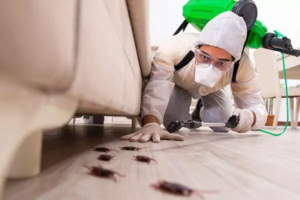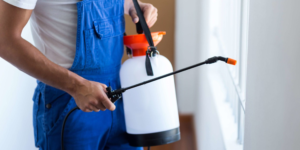Pest control aims to minimize the presence of unwanted animals, plants, or organisms. It involves prevention – keeping pests from entering; suppression – reducing their numbers to an acceptable level; and eradication – destroying the pest population entirely. Click https://southshoreipm.com/ to learn more.
Maintaining a hygienic home and removing food sources will greatly reduce the number of pests in your house. Consider also using parasitic nematodes (microscopic worms) to target grubs and other harmful insects in your garden.

The best way to prevent pest infestations is to eliminate their breeding grounds and remove the things that attract them. This includes food, water, and shelter. Several common items, including leftover food, improperly sealed trash cans, cracks in walls, and standing water, provide ideal breeding and feeding places for pests.
Structural prevention is a key aspect of effective pest control, and involves inspecting a building’s exterior for entry points that pests can use. A thorough inspection should include all areas where utility lines, vents, and pipes enter or exit the property. If these areas are found to be open, then they should be sealed with caulk. Cracks and gaps should also be filled in with caulk or other material to prevent pests from accessing the property. Doors should be checked for proper seals and weather stripping, and windows should have screens that are in good condition.
Clutter is another major source of pests, and should be removed as often as possible. This includes stacks of newspapers, magazines, and cardboard. Vacuuming and cleaning regularly is also important, and should include all areas where pests could breed or hide. Bug zappers and other repellents can be useful in keeping pests away from homes and offices.
Moisture is also a major attractant for many pests, and should be controlled by fixing leaky pipes and drains. Humid regions should be ventilated and dehumidified to reduce moisture levels.
Physical pest control methods involve traps, bait stations, and sprays. Traps are effective for capturing pests, but they must be checked and emptied frequently to be effective. Bait stations are more reliable, but they must be set in locations where pests are unlikely to find them. Sprays are also an option for controlling pests, but must be used carefully in order to avoid cross-contamination with foods and other products in production, processing, and packaging environments.
Pesticides are chemical substances that kill or control pests, but can be harmful to humans and other animals if misapplied or used incorrectly. Proper training and safety precautions must be taken when using pesticides, and only a qualified professional should use them.
Suppression
Typically, pest control is applied in an effort to reduce the number of unwanted insects and animals. This is done by eliminating their food sources and restricting their access to shelter or water. It also includes the removal of their breeding grounds. This prevents pests from multiplying and causing damage.
This is the best way to prevent pest infestations. Preventive methods include barriers to pests, such as repellents and traps. Physical pest control includes the use of traps, bait stations, and pheromones to lure and kill pests. These are particularly useful for rodents and insects that live in offices, hospitals, hotels and other business locations.
A more advanced method of prevention is to introduce natural enemies into the environment to prey on pests. These organisms could be predators, parasitoids or disease-causing microorganisms. Classical biological control involves raising the natural enemies in the laboratory, and then releasing them into the environment in small batches at regular intervals or in one large batch. This type of pest control works because the natural enemies usually breed and thrive in the local habitat.
To be successful, biological pest control must work in conjunction with other pest management techniques. For example, planting native plants that serve as food for the natural predators and parasitoids can help control pest populations. This also helps the ecosystem function as it should, by balancing the populations of both the plant-feeding and the pest species.
Many pests are not only damaging to the environment and property; they can also cause diseases in humans and animals. Cockroaches, flies, mosquitoes, fleas and ticks can transmit human diseases such as malaria, typhus, plague, Lyme disease, and salmonella poisoning. Other pests like caterpillars and beetles can destroy cultivated crops.
In homes, the most common pests are rodents and insects that contaminate food and other possessions. They can also damage indoor environments by chewing, gnawing or burrowing. Many of these pests are also a nuisance by detracting from the appearance of buildings and yards. They may also carry harmful bacteria that can affect human health. Pests are also a significant economic burden, as the loss of food caused by pests each year exceeds billions of rands in South Africa.
Detection
The first step in pest control is to detect a problem before it becomes a catastrophe. Whether it’s rats, termites, cockroaches or bed bugs, pests can cause serious problems and lead to expensive repairs or even health issues, so it is important to recognize the signs of infestation early on. Fortunately, there are several telltale signs of pests that can help you spot the problem before it escalates.
The simplest way to detect a pest problem is to look for visual cues, such as droppings or rotting food. Rodents leave pellet-shaped droppings that resemble coffee grounds, while termites and cockroaches often produce small dark-colored droppings. These droppings can indicate a pest problem because they are often contaminated with bacteria and other disease-causing agents, as well as rotted food.
If you see these droppings, make sure to clean them up right away to prevent further damage and contamination. You should also pay attention to any sounds coming from your home or building. Scratching and scurrying noises, especially at night, usually indicate the presence of rodents, such as mice and rats. You should also listen for chirping, squeaking or gnawing sounds. These sounds are a sign that pests are living in your walls or attic.
It’s also important to keep in mind that many pest species have distinct odors. A rat’s urine-like smell, for example, is easy to identify, while the scent of a cockroach can be quite distinctive.
Lastly, a pest infestation is also often accompanied by an increase in humidity or temperature in a room or space. These conditions can accelerate the infestation process, making it more difficult to eliminate the pests.
If you are unsure what kind of pest you are dealing with, it is best to seek the advice of a professional. They will be able to identify the pest and provide appropriate treatment methods. In addition, they will be able to recommend any corrective measures that should be taken to prevent the pests from infesting again in the future. In this way, they can save you a lot of money and stress down the road.
Treatment
Pests can cause damage to buildings, crops, or products, and can also lead to disease in humans or animals. Control of pests can prevent or reduce such damage. The main methods of pest control are prevention, suppression, and treatment. Prevention involves removing things that attract pests, and eliminating conditions in which they thrive. Treatment involves applying one or more methods to kill or repel them.
Some pests are killed or deterred by the actions of their natural enemies, such as parasites and predators. This is called biological control. There is often a time lag between when a pest population increases and when its natural controls become established in the area. Chemicals may be used to supplement biological control, especially if the threat is severe.
Physical barriers, such as traps and screens, can be used to prevent pests from entering buildings. Doors and windows should be tightly closed, and gaps should be caulked or sealed with quality materials. Clutter should be removed, and areas around pipes, drains, and vents should be cleaned regularly. Regular trash collection can help control pests in food processing environments, as can the use of containers with tight lids for all waste.
Plants, trees, and shrubs near a building should be kept trimmed so they don’t provide hiding places or access to upper floors. Wood piles should be stacked away from the building, and vines and other climbing plants should be removed.
Other physical controls include radiation and electricity, which can alter the environment enough to discourage or kill pests. Chemicals such as carbon dioxide, ethylene, and chlorine can also be used to control certain pests.
Many pests can be controlled without the use of chemicals, though this depends on the kind of pest and the situation. For example, nematodes can be introduced to the soil to kill insects that damage vegetables and fruits. Other non-toxic options include the use of pheromones, which can confuse male pests and reduce their numbers, and juvenile hormones, which can keep immature pests from maturing into normal adults.
Whenever possible, the goal should be to avoid the need for treatments by implementing preventive pest management practices. But if treatments are necessary, it’s best to do them right the first time. This way, you can concentrate on preventing future infestations rather than spending your valuable time trying to get rid of an existing infestation.

